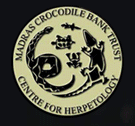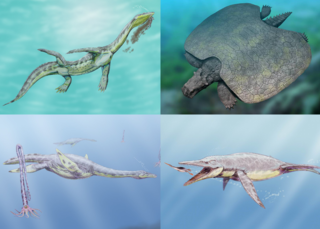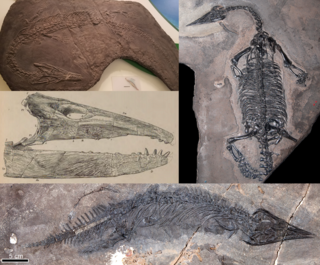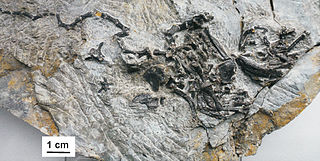The Mesozoic Era is the second-to-last era of Earth's geological history, lasting from about 252 to 66 million years ago, comprising the Triassic, Jurassic and Cretaceous Periods. It is characterized by the dominance of gymnosperms and of archosaurian reptiles, such as the dinosaurs; a hot greenhouse climate; and the tectonic break-up of Pangaea. The Mesozoic is the middle of the three eras since complex life evolved: the Paleozoic, the Mesozoic, and the Cenozoic.

Reptiles, as commonly defined, are a group of tetrapods with an ectothermic ('cold-blooded') metabolism and amniotic development. Living reptiles comprise four orders: Testudines (turtles), Crocodilia (crocodilians), Squamata, and Rhynchocephalia. As of May 2023, about 12,000 living species of reptiles are listed in the Reptile Database. The study of the traditional reptile orders, customarily in combination with the study of modern amphibians, is called herpetology.
Several groups of tetrapods have undergone secondary aquatic adaptation, an evolutionary transition from being purely terrestrial to living at least part of the time in water. These animals are called "secondarily aquatic" because although their ancestors lived on land for hundreds of millions of years, they all originally descended from aquatic animals. These ancestral tetrapods had never left the water, and were thus primarily aquatic, like modern fishes. Secondary aquatic adaptations tend to develop in early speciation as the animal ventures into water in order to find available food. As successive generations spend more time in the water, natural selection causes the acquisition of more adaptations. Animals of later generations may spend most their life in the water, coming ashore for mating. Finally, fully adapted animals may take to mating and birthing in water or ice.

The saltwater crocodile is a crocodilian native to saltwater habitats, brackish wetlands and freshwater rivers from India's east coast across Southeast Asia and the Sundaic region to northern Australia and Micronesia. It has been listed as Least Concern on the IUCN Red List since 1996. It was hunted for its skin throughout its range up to the 1970s, and is threatened by illegal killing and habitat loss. It is regarded as dangerous to humans.

The Madras Crocodile Bank Trust and Centre for Herpetology (MCBT) is a reptile zoo and herpetology research station, located 40 kilometres (25 mi) south of the city of Chennai, in state of Tamil Nadu, India. The centre is both a registered trust and a recognized zoo under the Wildlife (Protection) Act, 1972 and comes under the purview of the Central Zoo Authority, Ministry of Environment, Forest and Climate Change, Government of India. It was established with the aim of saving three Indian endangered species of crocodile—the marsh or mugger crocodile, the saltwater crocodile, and the gharial, which at the time of founding of the trust were all nearing extinction.

The American crocodile is a species of crocodilian found in the Neotropics. It is the most widespread of the four extant species of crocodiles from the Americas, with populations present from South Florida, the Greater Antilles Archipelago, and the coasts of Mexico to as far south as Peru, Ecuador, Colombia, and Venezuela.

Sauropterygia is an extinct taxon of diverse, aquatic reptiles that developed from terrestrial ancestors soon after the end-Permian extinction and flourished during the Triassic before all except for the Plesiosauria became extinct at the end of that period. The plesiosaurs would continue to diversify until the end of the Mesozoic. Sauropterygians are united by a radical adaptation of their pectoral girdle, adapted to support powerful flipper strokes. Some later sauropterygians, such as the pliosaurs, developed a similar mechanism in their pelvis.

Placodonts are an extinct order of marine reptiles that lived during the Triassic period, becoming extinct at the end of the period. They were part of Sauropterygia, the group that includes plesiosaurs. Placodonts were generally between 1 and 2 m in length, with some of the largest measuring 3 m (9.8 ft) long.

Thalattosauria is an extinct order of prehistoric marine reptiles that lived in the Middle to Late Triassic. Thalattosaurs were diverse in size and shape, and are divided into two superfamilies: Askeptosauroidea and Thalattosauroidea. Askeptosauroids were endemic to the Tethys Ocean, their fossils have been found in Europe and China, and they were likely semiaquatic fish eaters with straight snouts and decent terrestrial abilities. Thalattosauroids were more specialized for aquatic life and most had unusual downturned snouts and crushing dentition. Thalattosauroids lived along the coasts of both Panthalassa and the Tethys Ocean, and were most diverse in China and western North America. The largest species of thalattosaurs grew to over 4 meters (13 feet) in length, including a long, flattened tail utilized in underwater propulsion. Although thalattosaurs bore a superficial resemblance to lizards, their exact relationships are unresolved. They are widely accepted as diapsids, but experts have variously placed them on the reptile family tree among Lepidosauromorpha, Archosauromorpha, ichthyosaurs, and/or other marine reptiles.

Sea Monsters: A Prehistoric Adventure is a 2007 American IMAX 3D documentary film by National Geographic, about prehistoric marine reptiles. It alternates modern-day sequences about the work of scientists studying the animals with computer-animated scenes depicting the prehistoric past.

Marine vertebrates are vertebrates that live in marine environments. These are the marine fish and the marine tetrapods. Vertebrates are a subphylum of chordates that have a vertebral column (backbone). The vertebral column provides the central support structure for an internal skeleton. The internal skeleton gives shape, support, and protection to the body and can provide a means of anchoring fins or limbs to the body. The vertebral column also serves to house and protect the spinal cord that lies within the column.

Tangasauridae is an extinct family of diapsids known from fossil specimens from Madagascar, Kenya and Tanzania that are Late Permian to Early Triassic in age. Fossils have been found of numerous specimens of common members of this family such as Hovasaurus in different stages of ontogenic development. Recent material from the Middle Sakamena Formation of the Morondava Basin of Madagascar that dates back to the early Triassic period suggests that the Tangasauridae were relatively unaffected by the Permian-Triassic extinction event.

Helveticosaurus is an extinct genus of diapsid marine reptile known from the Middle Triassic of southern Switzerland. It contains a single species, Helveticosaurus zollingeri, known from the nearly complete holotype T 4352 collected at Cava Tre Fontane of Monte San Giorgio, an area well known for its rich record of marine life during the Middle Triassic.

Reptiles arose about 320 million years ago during the Carboniferous period. Reptiles, in the traditional sense of the term, are defined as animals that have scales or scutes, lay land-based hard-shelled eggs, and possess ectothermic metabolisms. So defined, the group is paraphyletic, excluding endothermic animals like birds that are descended from early traditionally-defined reptiles. A definition in accordance with phylogenetic nomenclature, which rejects paraphyletic groups, includes birds while excluding mammals and their synapsid ancestors. So defined, Reptilia is identical to Sauropsida.
Vivian de Buffrénil is a French histologist and paleobiologist who has worked at the Muséum National d'Histoire Naturelle in Paris from 1982 to 2021. His doctorate (1980) and his doctorat d'état (1990), a diploma now replaced by the habilitation, were supervised by Armand de Ricqlès. His main fields of interest include basic histological descriptions, growth dynamics as recorded in bone growth marks, and adaptation of the tetrapod skeleton to a secondarily aquatic lifestyle. He is also interested in life history and population dynamics of exploited or threatened reptile taxa, especially among Varanidae and Crocodilia. He has published at least 92 papers, including 76 research papers, 10 reports on exploited or threatened species, and six popular papers.

Pappochelys is an extinct genus of diapsid reptile possibly related to turtles. The genus contains only one species, Pappochelys rosinae, from the Middle Triassic of Germany, which was named by paleontologists Rainer Schoch and Hans-Dieter Sues in 2015. The discovery of Pappochelys provides strong support for the placement of turtles within Diapsida, a hypothesis that has long been suggested by molecular data, but never previously by the fossil record. It is morphologically intermediate between the definite stem-turtle Odontochelys from the Late Triassic of China and Eunotosaurus, a reptile from the Middle Permian of South Africa.

Crocodylus Park is a zoo situated in Knuckey Lagoon, Northern Territory, Australia. It specialises in the conservation of saltwater and freshwater crocodiles and features a comprehensive crocodile museum. The park also has big cats, monkeys, birds, turtles and snakes.


















